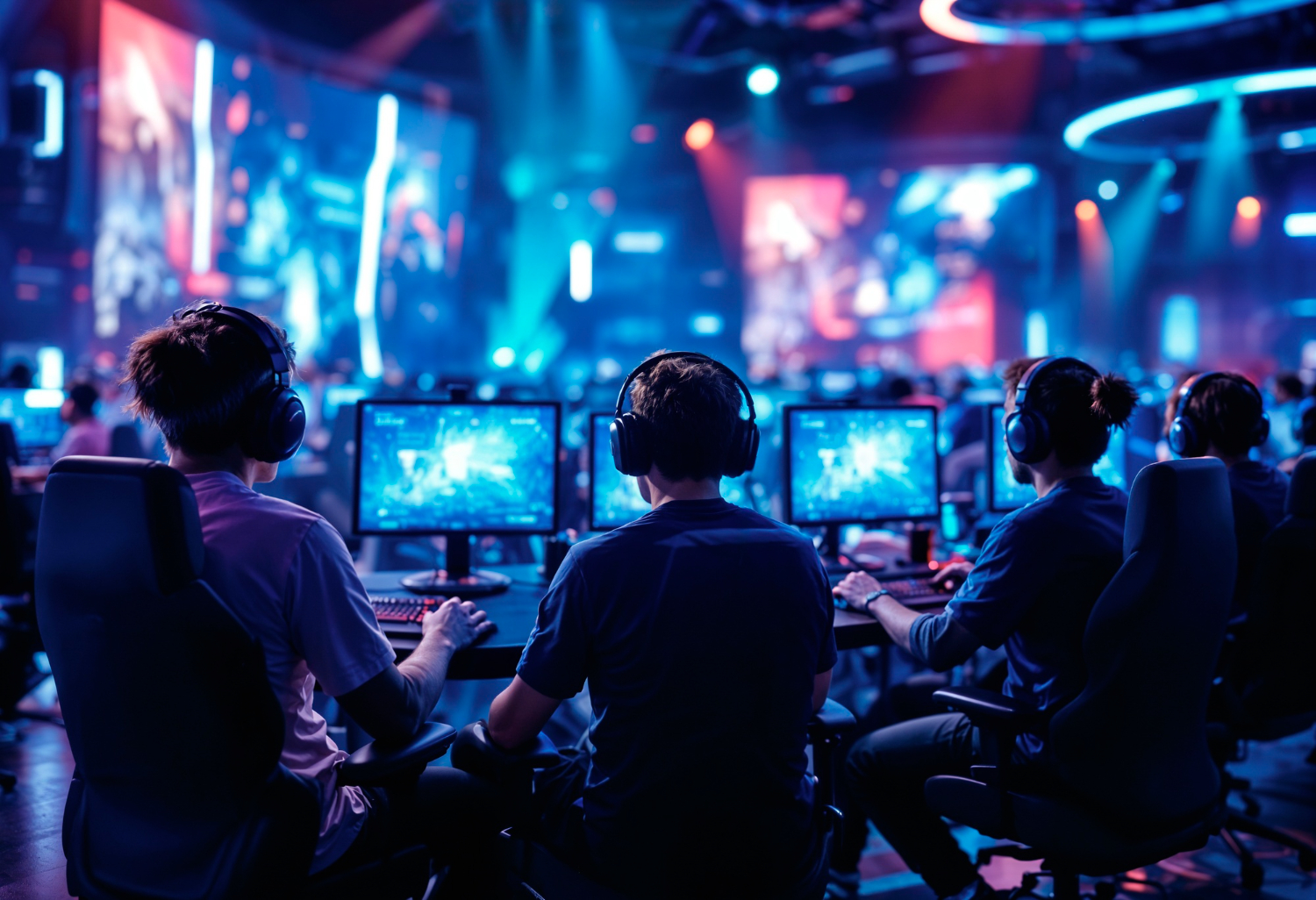Table of contents
In recent years, the rise of esports has transformed the world of competitive gaming into a globally recognized phenomenon. What was once considered a hobby or pastime is now a legitimate and thriving professional sport. With massive tournaments, sponsorship deals, professional teams, and a dedicated global fanbase, esports has firmly established itself as one of the fastest-growing industries in the world.
In this blog post, we’ll explore how esports have evolved from grassroots gaming to professional tournaments, the impact of technology on esports, and why professional gaming is now being recognized as a competitive sport on par with traditional athletic events.
What is Esports?
Esports refers to organized multiplayer video game competitions, often involving professional players, teams, and spectators. The games played in esports tournaments range from first-person shooters (FPS) like Counter-Strike and Call of Duty to real-time strategy games (RTS) such as StarCraft, and multiplayer online battle arena (MOBA) games like League of Legends and Dota 2.
Esports tournaments are often streamed live on platforms like Twitch, YouTube, and Facebook Gaming, and are frequently broadcast on television networks and esports-specific channels, drawing millions of viewers worldwide.
In these competitive tournaments, professional players, coaches, analysts, and even broadcasters all contribute to making esports an organized and structured competitive ecosystem. Teams of highly skilled players compete against one another for large cash prizes, sponsorship deals, and global recognition.
The Evolution of Esports: From Hobby to Industry
The rise of esports can be traced back to the early days of multiplayer gaming in the 1990s. As games like Warcraft, Quake, and StarCraft began to introduce competitive features, players started organizing tournaments and competitions. While these early events were smaller in scale, they planted the seeds for the esports scene that would grow into the global industry it is today.
One of the pivotal moments in the development of esports came in 1997 with the creation of the World Cyber Games (WCG), often regarded as the first major international esports tournament. It featured players from around the world competing in games such as StarCraft and Counter-Strike, and it helped solidify competitive gaming as a legitimate form of sport.
Over the years, esports continued to evolve, with games like League of Legends, Overwatch, and Fortnite taking the world by storm, each with their own massive esports leagues and tournaments. Today, esports events such as The International (Dota 2) and the League of Legends World Championship attract millions of viewers, with prize pools reaching tens of millions of dollars.
The rise of platforms like Twitch and YouTube Gaming has further fueled the growth of esports, providing gamers with a platform to stream their gameplay and interact with fans. This has not only provided professional players with additional revenue streams but has also helped cultivate a global, passionate fanbase that follows and supports esports tournaments year-round.
Professional Esports: The Making of Competitive Athletes
As the rise of esports continues, the line between video gaming and traditional sports has become increasingly blurred. Professional gamers now undergo rigorous training, much like athletes in traditional sports, and many esports players have similar demands placed on them when it comes to their physical and mental preparation.
Training and Practice
Professional gamers are known to practice for hours each day, honing their skills and improving their strategies. Much like athletes, esports players must maintain sharp reflexes, deep game knowledge, and strong mental endurance. The physical aspect of esports is often overlooked, but the repetitive movements and intense focus required for gaming can lead to physical strain, much like the demands placed on professional athletes in traditional sports.
Players often work with coaches who analyze their gameplay, identify areas for improvement, and devise strategies to give them a competitive edge. This coaching and strategic development is similar to what you’d find in traditional team sports like football or basketball, making professional esports teams well-coordinated units.
Mental Endurance
One of the most crucial aspects of professional gaming is mental endurance. Competitive gaming requires players to make rapid decisions, adapt to ever-changing in-game scenarios, and maintain focus for long periods of time. Mental fortitude is often what separates the best players from the rest.
Esports organizations are now incorporating mental training, stress management, and psychological support to help players cope with the pressure of high-stakes competitions. This holistic approach to training reflects the importance of mental health in professional gaming, and many esports organizations are now prioritizing player well-being to avoid burnout.
The Role of Technology in Esports
Technology plays a pivotal role in the rise of esports, impacting both the gameplay itself and the way tournaments are organized. High-performance gaming hardware, cutting-edge streaming technologies, and advanced analytics have revolutionized the esports industry.
Advanced Gaming Hardware
To compete at the highest levels, esports players require the best possible equipment. This includes high-refresh-rate monitors, fast-response keyboards, and specialized gaming mice. Esports teams are also equipped with state-of-the-art gaming PCs with powerful processors, high-end graphics cards, and low-latency internet connections, all of which give them the edge they need to perform at their peak.
Streaming and Broadcasting
The advent of streaming platforms like Twitch has been a game-changer for esports. These platforms allow players and teams to broadcast their gameplay live to an audience of millions. With features like live chat, viewers can interact with players, ask questions, and engage with the gaming community in real time. This has helped to create a global esports culture and has given players a platform to gain fans and sponsorships.
Esports Analytics and Data
As esports has evolved into a professional sport, teams have begun utilizing advanced data analytics and performance tracking to improve player performance. Esports organizations are employing AI and machine learning algorithms to analyze players’ actions in real-time, allowing coaches to review critical decisions and identify areas for improvement.
This data-driven approach helps optimize player training and strategy, ensuring that teams are always at the forefront of competitive gaming. Analytics are also used by broadcasters to provide viewers with real-time statistics and insights, enhancing the viewer experience and making esports more engaging for fans.
The Global Impact of Esports
Esports is no longer a niche subculture—it’s a global industry. The rise of esports has led to a significant cultural shift, with millions of fans attending live events, watching streams, and following their favorite teams. Esports has grown into a multi-billion-dollar industry, attracting sponsorships from major brands, including Coca-Cola, Intel, and Nike.
In addition to professional tournaments, esports has become a significant part of the educational system. Many universities and colleges are now offering scholarships for esports players, and some even have dedicated esports teams. This has legitimized competitive gaming as a career path, with professional gamers gaining the same recognition and respect as athletes in traditional sports.
Frequently Asked Questions (FAQ)

Esports refers to organized multiplayer video game competitions, typically between professional players and teams, in various gaming genres, such as FPS, RTS, and MOBA games.
Technology on sports has enhanced esports by providing advanced gaming hardware, high-quality streaming platforms, and performance analytics, allowing players and teams to perform at their best.
Yes, many people consider professional gamers athletes due to the intense mental and physical demands of their training and competitions, including hours of practice, strategic planning, and mental fortitude.
Some of the most popular esports games include League of Legends, Counter-Strike: Global Offensive (CS: GO), Dota 2, Overwatch, Fortnite, and Call of Duty.
Platforms like Twitch, YouTube Gaming, and Facebook Gaming broadcast esports tournaments live, and television networks dedicated to esports coverage can also show them.
Final Thoughts
The rise of esports has transformed competitive gaming into a global, multi-billion-dollar industry. With professional teams, global tournaments, and ever-growing fanbases, esports has firmly established itself as a competitive sport. The integration of cutting-edge technology, data analytics, and streaming platforms has revolutionized the way players train, compete, and interact with their fans.
As the esports industry continues to expand and evolve, it will undoubtedly continue to capture the imaginations of millions around the world, providing new opportunities for players, coaches, broadcasters, and fans alike.




